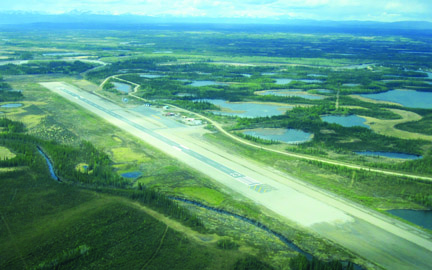
During World War II, the U.S. supplied the Soviet Union with fighter planes by ferrying up the west coast and across the Bering Strait. This era’s fighter planes had small fuel tanks, short ranges and required numerous runways for frequent refueling on their way to Siberia.
One of these runways was constructed at Northway, Alaska. Northway was later used for cold weather testing of Army helicopters because temperatures reach -70 degrees F. Winters are so cold that the ground stays frozen through the summer. In 1983, Armak’s Highway Chemicals division (now Akzo-Nobel) sent me to Northway to pave this runway.
Alaska’s highway system is not as well developed as the lower 48 states due to its extreme size and small population. Small aircraft are often used to cover large distances over rough terrain making airports important. Forty years after World War II, Northway airport’s runway needed repaving but the Federal Aviation Administration (FAA) was concerned because the area is permafrost – soil at or below the freezing point of water.
The existing runway was a primitive cold mix that used cutback asphalt (solvent diluted asphalt cement). This technique is no longer commonly used because it releases large amounts of hydrocarbons and could ignite.
To control costs and protect the environment, the new runway would use local aggregate and not melt the permafrost. Portland cement concrete was difficult and expensive to transport. Hot mix asphalt could heat-damage the frozen ground. This was a good test for cold mix asphalt using available water and aggregate. This was decades before LEED (Leadership in Energy and Environmental Design) was created.
At the same time, Armak’s Highway Chemicals Division Research Manager Jack Dybalski was working to show that cold mix could have the same strength per unit thickness as hot mix. This could be extremely useful in remote areas where no hot mix or ready-mix plants were located. Jack reminded me that cold mix lacked the stiffening that hot mix binder gets from heating. I received Northway aggregate samples and made test mixes using slow setting cationic asphalt emulsion (CSS-1). Mixing time and mix curing time were easily adjusted by adjusting the zeta potential (electric charge) and concentration of the emulsifier.
Asphalt was locally available from a small refinery (MAPCO) that tapped into the Alaska pipeline and refined fuels. Asphalt emulsification was performed by the contractor. The contractor also used a self-propelled mixer paving machine. Paving half the runway at a time allowed the airport to remain open. Visiting bush pilots showed off by landing in the parking lot.
As the job progressed, problems developed. The mixing and set time changed. The sample used to formulate the mix design did not represent what we were seeing. The sample was from the surface of the aggregate deposit, which had few fines. As the borrow pit deepened, the amount of fines increased. Over countless years, fine materials accumulated by percolating down. When frozen aggregate was dug out, the ice would melt and raise the moisture content too high for good cold mix (diluting the emulsion).
A new Marshall mix design was needed fast. Everyone helped with this work because the Marshall hammer was not motorized and the FAA required 75 blows instead of 50 for highway paving. Formulation was still challenging because fines (passing #200 U.S. sieve) went from 6 to 18 percent and extra fines (passing #325 U.S. sieve) climbed to 6 percent. Moisture also was too high (6 percent) for a good design. P325 fines create too much surface area for emulsifier to coat and mix time disappears (causing instant breaking inside the pug-mill). The contractor’s solution was to use a portable plant to dry and blow some fines out of the aggregate pile. Moisture and fines were reduced enough to allow completion of the project.
An extreme test came a few months after paving. The U.S. Army landed a cargo plane carrying an 80,000-pound dozer. The gross weight of plane and dozer was 300,000 pounds. The pavement stood up well and the only distress was a single spot where a locked wheel turned and moved the pavement with it. Upon visiting the pavement the following summer, I could not find any rutting or cracking. The FAA and Alaska DOT considered this runway project a success.
Alaska Department of Transportation District Superintendent Dennis Bishop reported the runway was destroyed in a major earthquake (7.9) in 2003. The earthquake liquefied the frozen base and cracked the pavement.
“I feel the runway held up well over the years until the earthquake. I do not think that any other pavement would have held up much better,” Bishop said.
Northway airport was repaired soon after the quake and completely rebuilt in 2008 with hot mix.
Mark Homer is manager of Ajax Paving Inc. asphalt terminal in Detroit, Michigan.













